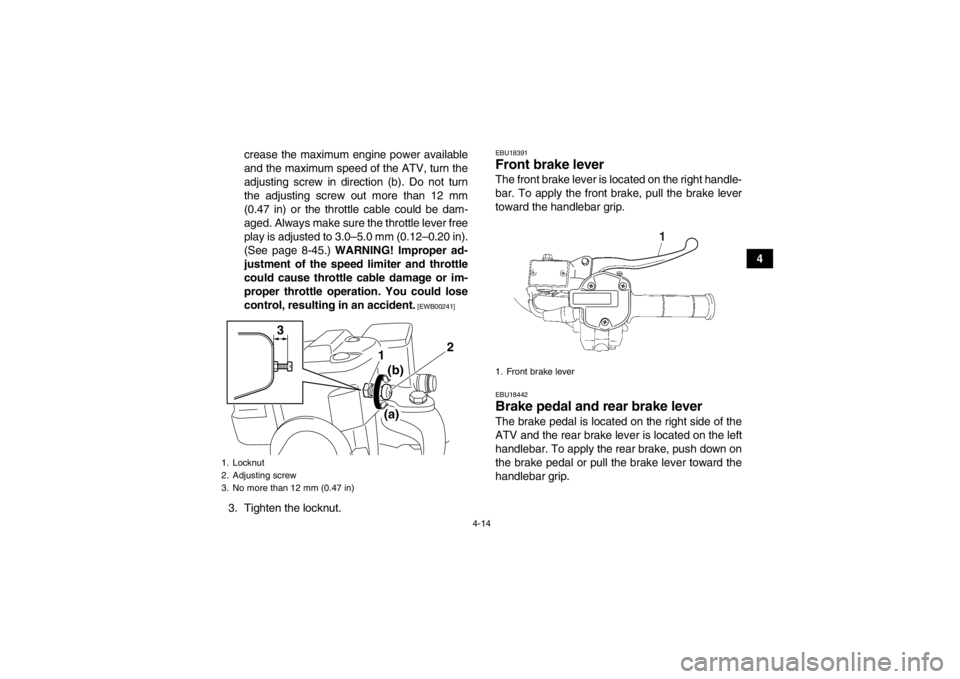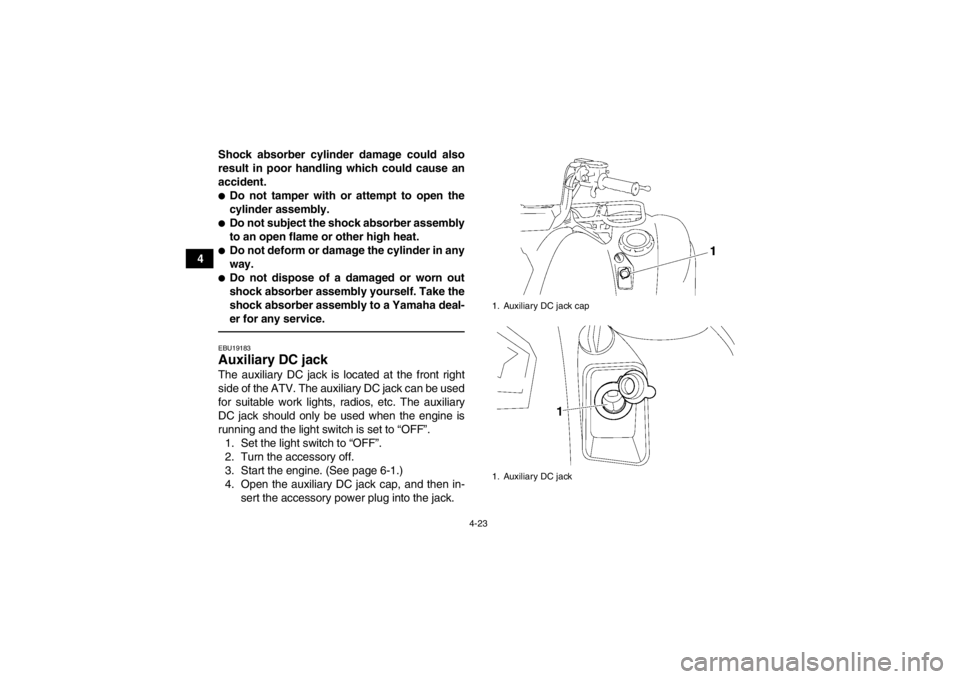Page 43 of 174

4-14
4
crease the maximum engine power available
and the maximum speed of the ATV, turn the
adjusting screw in direction (b). Do not turn
the adjusting screw out more than 12 mm
(0.47 in) or the throttle cable could be dam-
aged. Always make sure the throttle lever free
play is adjusted to 3.0–5.0 mm (0.12–0.20 in).
(See page 8-45.) WARNING! Improper ad-
justment of the speed limiter and throttle
could cause throttle cable damage or im-
proper throttle operation. You could lose
control, resulting in an accident.
[EWB00241]
3. Tighten the locknut.
EBU18391Front brake lever The front brake lever is located on the right handle-
bar. To apply the front brake, pull the brake lever
toward the handlebar grip.EBU18442Brake pedal and rear brake lever The brake pedal is located on the right side of the
ATV and the rear brake lever is located on the left
handlebar. To apply the rear brake, push down on
the brake pedal or pull the brake lever toward the
handlebar grip.
1. Locknut
2. Adjusting screw
3. No more than 12 mm (0.47 in)
2
1
3
(b)
(a)
1. Front brake lever
U1HP61E0.book Page 14 Thursday, April 5, 2012 3:33 PM
Page 45 of 174
4-16
4
To install the fuel tank cap
Install the fuel tank cap by turning it clockwise until
a click is heard, and then close the fuel tank cap
cover.
EBU18755Fuel Make sure there is sufficient gasoline in the tank.
WARNING
EWB02521Gasoline and gasoline vapors are extremely
flammable. To avoid fires and explosions and
to reduce the risk of injury when refueling, fol-
low these instructions.1. Before refueling, turn off the engine and be
sure that no one is sitting on the vehicle. Nev-
er refuel while smoking, or while in the vicinity
of sparks, open flames, or other sources of ig-
nition such as the pilot lights of water heaters
and clothes dryers.
2. Do not overfill the fuel tank. When refueling, be sure to insert the pump nozzle into the fuel
tank filler hole. Stop filling when the fuel reach-
es the bottom of the filler tube. Because fuel
1. Fuel tank cap cover
1. Fuel tank capU1HP61E0.book Page 16 Thursday, April 5, 2012 3:33 PM
Page 46 of 174

4-17
4expands when it heats up, heat from the en-
gine or the sun can cause fuel to spill out of
the fuel tank.
3. Wipe up any spilled fuel immediately.
NOTICE: Immediately wipe off spilled fuel
with a clean, dry, soft cloth, since fuel may
deteriorate painted surfaces or plastic
parts.
[ECB00981]
4. Turn the fuel tank cap fully clockwise to make sure it is securely closed.
WARNING
EWB02531Gasoline is poisonous and can cause injury or
death. Handle gasoline with care. Never siphon
gasoline by mouth. If you should swallow
some gasoline or inhale a lot of gasoline vapor,
or get some gasoline in your eyes, see your
doctor immediately. If gasoline spills on your
skin, wash with soap and water. If gasoline
spills on your clothing, change your clothes.NOTICEECB00070Use only unleaded gasoline. The use of leaded
gasoline will cause severe damage to internal
engine parts, such as the valves and piston
rings, as well as to the exhaust system.
1. Maximum fuel level
2. Fuel tank filler tubeRecommended fuel:UNLEADED GASOLINE ONLY
For Europe: Regular unleaded gasoline only
with a research octane number of 95 or
higher
Fuel tank capacity: 20.0 L (5.28 US gal, 4.40 Imp.gal)
Fuel reserve amount: 4.5 L (1.19 US gal, 0.99 Imp.gal)
U1HP61E0.book Page 17 Thursday, April 5, 2012 3:33 PM
Page 47 of 174
4-18
4
Your Yamaha engine has been designed to use
regular unleaded gasoline with a research octane
number of 91 or higher (95 or higher for Europe). If
knocking (or pinging) occurs, use a gasoline of a
different brand. Use of unleaded fuel will extend
spark plug life and reduce maintenance costs.
EBU18881Seat To remove the seat
Pull the seat lock lever upward and pull up the seat
at the rear. To install the seat
Insert the projections on the front of the seat into
the seat holders and push down on the seat at the
rear. Make sure that the seat is securely fitted.
EBU27362Storage compartments This ATV is equipped with two storage compart-
ments.
1. Seat
2. Seat lock lever
1. Projection
2. Seat holder
U1HP61E0.book Page 18 Thursday, April 5, 2012 3:33 PM
Page 52 of 174

4-23
4Shock absorber cylinder damage could also
result in poor handling which could cause an
accident.
●Do not tamper with or attempt to open the
cylinder assembly.●Do not subject the shock absorber assembly
to an open flame or other high heat.●Do not deform or damage the cylinder in any
way.●Do not dispose of a damaged or worn out
shock absorber assembly yourself. Take the
shock absorber assembly to a Yamaha deal-
er for any service.EBU19183Auxiliary DC jack The auxiliary DC jack is located at the front right
side of the ATV. The auxiliary DC jack can be used
for suitable work lights, radios, etc. The auxiliary
DC jack should only be used when the engine is
running and the light switch is set to “OFF”.
1. Set the light switch to “OFF”.
2. Turn the accessory off.
3. Start the engine. (See page 6-1.)
4. Open the auxiliary DC jack cap, and then in- sert the accessory power plug into the jack.
1. Auxiliary DC jack cap
1. Auxiliary DC jack
U1HP61E0.book Page 23 Thursday, April 5, 2012 3:33 PM
Page 53 of 174
4-24
4
5. Turn the accessory on.
6. When the auxiliary DC jack is not being used,
cover it with the cap.
NOTICEECB00120●Do not use accessories requiring more than
the above maximum capacity. This may
overload the circuit and cause the fuse to
blow.●If accessories are used without the engine
running or with the headlights turned on, the
battery will lose its charge and engine start-
ing may become difficult.●Do not use an automotive cigarette lighter or
other accessories with a plug that gets hot
because the jack can be damaged.Maximum rated capacity for the auxiliary DC
jack:DC 12 V, 10 A (120 W)
U1HP61E0.book Page 24 Thursday, April 5, 2012 3:33 PM
Page 54 of 174

5-1
5
EBU19201
PRE-OPERATION CHECKS
EBU19224Inspect your vehicle each time you use it to make sure the vehicle is in safe operating condition. Always
follow the inspection and maintenance procedures and schedules described in the Owner’s Manual.
WARNING
EWB00481Failure to inspect or maintain the vehicle properly increases the possibility of an accident or equip-
ment damage. Do not operate the vehicle if you find any problem. If a problem cannot be corrected
by the procedures provided in this manual, have the vehicle inspected by a Yamaha dealer.Before using this vehicle, check the following points:
ITEMROUTINE PAGE
Fuel Check fuel level in fuel tank, and add recommended fuel if neces-
sary.
Check fuel line for leakage. Correct if necessary. 4-16, 5-3
Engine oil Check oil level in engine, and add recommended oil to specified lev-
el if necessary.
Check ATV for oil leakage. Correct if necessary. 5-3, 8-22
Final gear oil Check ATV for oil leakage. Correct if necessary. 5-3, 8-27
Differential gear oil Check ATV for oil leakage. Correct if necessary. 5-3, 8-29
Coolant Check coolant level in reservoir, and add recommended coolant to
specified level if necessary.
Check cooling system for leakage. Correct if necessary. 5-3, 8-32
U1HP61E0.book Page 1 Thursday, April 5, 2012 3:33 PM
Page 56 of 174

5-3
5
EBU19541Fuel Make sure that there is sufficient fuel in the tank.
(See page 4-16.)EBU19560Engine oil Make sure that the engine oil is at the specified lev-
el. Add oil as necessary. (See page 8-22.)EBU19590Final gear oil Make sure that the final gear oil is at the specified
level. Add oil as necessary. (See page 8-27.)EBU19600Differential gear oil Make sure that the differential gear oil is at the
specified level. Add oil as necessary. (See page
8-29.)EBU19631Coolant Make sure that the coolant is at the specified level.
Add coolant as necessary. (See page 8-32.)
TIPThe coolant level must be checked on a cold en-
gine since the level varies with engine tempera-
ture.EBU29082Front and rear brakes Brake levers and brake pedal●Check that there is no free play in the front and
rear brake levers. If there is free play, have a
Yamaha dealer check the brake system.●Check for correct free play in the brake pedal. If
the free play is incorrect, adjust it. (See page
8-50.)●Check the operation of the brake levers and
pedal. They should move smoothly and there
should be a firm feeling when the brakes are ap-
plied. If not, have a Yamaha dealer check the
brake system.
Brake fluid level
Check the brake fluid level. Add fluid if necessary.
(See page 8-48.)
U1HP61E0.book Page 3 Thursday, April 5, 2012 3:33 PM